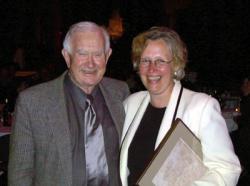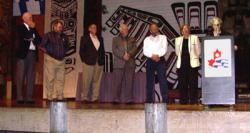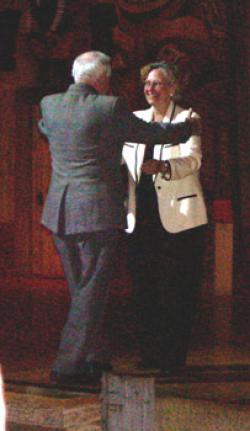



My purpose here tonight is two fold. First, to defend the people involved in the decision to award the Smith-Wintemberg Award to Jim Pendergast and second to convince you that he really is a nice guy who deserves this honour. The idea of nominating Jim arose on the way home from the OAS meetings in Waterloo last October. Jim was missed at that meeting, where several people made complimentary comments about him. I hitched a ride from Waterloo to Ottawa with Jean-Luc Pilon and during our conversation, the idea of nominating Jim for the Smith-Wintemberg Award was plotted. Having decided to nominate Jim, I needed to find people willing to write letters supporting the nomination. This was an easy task. More people than were necessary offered to write letters of support. As a final step in the procedures, the CAA executive readily agreed that Jim was a most appropriate recipient.
The Smith-Wintemberg Award, as you can read on the CAA web-page, is presented to honour members of the Canadian archaeological community who have made an outstanding contribution to the advancement of the discipline of archaeology, or to our knowledge of the archaeological past of Canada. To date, only seven others have received this award. This could be an after dinner game with you trying to see if you can name all seven and to make it more difficult to also give the years when they received their awards. Jim finds himself in good company. In 1978, Charles Borden and Norman Emerson were recipients; in 1984 Richard Forbis; in 1992 James Wright and William Taylor; in 1995, Roy Carlson, and in 1998 Donald Mitchell. Like these archaeologists before him, Jim Pendergast has contributed much to Canadian archaeology. He deserves this award under both of the stipulated criteria.
Certainly, Jim has made an outstanding contribution to the advancement of the discipline. Jim's reports are not only numerous but also they serve as models of clarity. Much of his basic data is presented in concise, tabular form for other researchers to consult. Furthermore, his reports are consistently examples of outstandingly careful analysis. When Jim first took up archaeology as a part-time endeavour, at the same time as he was excelling in his military career, he decided to concentrate on his home territory of southeastern Ontario. Jim was born in Cornwall in 1921. In 1946, while stationed in Ottawa, he decided to investigate the Iroquoian peoples Jacques Cartier had encountered in the upper St. Lawrence Valley. Thus Jim, in his spare time, with very little assistance and little funding, began to train himself in archaeology, to survey for sites, and to excavate some of those he located. Soon he was publishing his findings in reports that rivalled and continue to rival those of professional archaeologists. Particularly, but not exclusively, Jim's pottery studies were outstanding and with them he definitely advanced the discipline.
In 1972, Jim Pendergast retired from the military, where he had risen to the rank of lieutenant colonel after serving in the second world war. In the same year, he became the Assistant Director of the then National Museum of Man. In addition to organizing a large salvage program at the museum, Jim made another outstanding contribution to the advancement of archaeology by starting the Mercury Series, whose purpose was the rapid and inexpensive distribution of archaeological information from sites from across Canada. There are now more than 160 volumes in this series and it is still an ongoing legacy of Jim's 1972 to 1978 stint at the museum. Like the CAA, the Mercury Series has helped us stay in touch with each other across the various research areas and interests of Canadian archaeology.
This achievement leads me into a consideration of Jim's qualifications under the second criteria for the Smith-Wintemberg Award, that of contributing to our knowledge of the past of Canada. It is difficult to comment on this without making understatements. Simply put, Jim has discovered much of what we now know about the people we term the St. Lawrence Iroquoians . Without Jim's enthusiasm for finding, digging, and researching sites in this area, the archaeological knowledge about these people in the upper St. Lawrence Valley would be much less. He has encouraged others to do research on these people too. Because one of the earliest researchers in this area was Wintemberg, who excavated and reported on the Roebuck site, it seems really appropriate that Jim should be receiving this particular award. Related to his work on these Iroquoian peoples, Jim has become an expert on the Contact period archaeology of Eastern North America and has published several articles on trade. Jim has extended such studies to the Eastern States and has been recognized for his scholarship by several American organizations too. Jim is always punctual in reporting his findings both as conference papers and in publications, refereed and public. He puts many professionals to shame by his productivity, his continued enthusiasm for all aspects of archaeology, his willing to share in organizational work, his efforts to educate the public about archaeology, and his open communication with professionals and amateurs alike. Through his enthusiasm and generosity in sharing his data, some even before they are published, Jim has influenced many students, politicians, and other archaeologists. I count myself among the fortunate who have had the pleasure of working with this big-hearted, generous man.
And speaking of counting, following Jim's style, I will give you the raw data on his archaeological accomplishments. Jim has received 5 other archaeological awards and an Honorary Doctor of Science from McGill University. He is the sole author of 56 archaeological publications and a co-author of an additional 6. He has 4 more articles currently in press. He has presented at least 27 papers to learned societies, including this one. He has been the principal investigator of the excavations of two St. Lawrence Iroquoian villages and the consulting archaeologist for two hydro and gas projects. He has belonged to many professional and community organisations taking more than his share of the work in these, being a founding member of two, vice-president of two, including the CAA, and Chairman of another. Not bad for a fellow in retirement!
I now ask all of you to join with me in saluting Jim for his retiring ways and all that he has done for archaeology. Let us wish this well-deserving recipient of the Smith-Wintemberg Award, and his wife Margaret, many more happy years.
Frances L. Stewart
St. Thomas University
Frederiction, New Brunswick
Click here to listen to Jim's well-chosen words of gratitude, spoken at the awards ceremony in the Grand Hall of the Canadian Museum of Civilization, May 6, 2000.
The photographs were taken by Karen and Keith Murchison during the award ceremony May 6, 2000. Many thanks!
